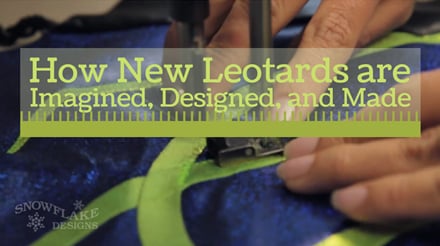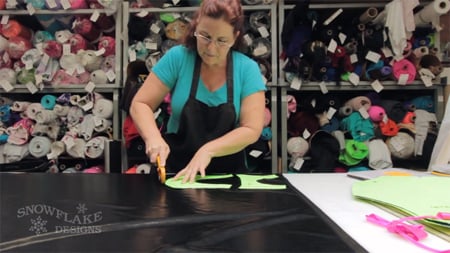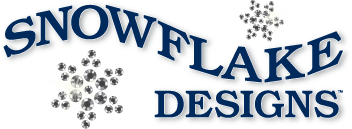How do we do this?
When you think about how new gymnastics leotards are made, do you imagine a giant factory full of machines, cranking out masses of leotards? Or do you picture someone’s Mom sewing elastic into a one-of-kind leotard design? At Snowflake Designs, we’re in a wonderful place between those two stories. We’re big enough to produce a lot of leotards so you have a wide selection at great prices, but small enough to care about every leotard.

More Like Project Runway than Production Line
Our gymnastics leotard business is much more like a fashion design house than a factory. If you’re a fan of the competition TV show Project Runway, then you know that the designers go from idea to design to runway-ready in a day or two. But that’s just TV magic, isn’t it? No, we’re able to take our new leotards from idea to prototype to commercially available production in a matter of days or weeks as well!
When you wear a Snowflake Leotard, it’s athletics, it’s competition, and it’s also fashion. We know that choosing a leotard is a complex blend of comfortable and functional fit as well as a personal preference for design and color.
Here’s how new leotards go from an idea, into production, and then to you… all within our family-owned and operated manufacturing facility in California.
Where New Leotard Ideas Come From
We get our ideas and inspiration from gymnastics of course, but also from color and fashion trends.
Gymnastics for girls brings strength, grace, and beauty together in one package. Like our athletes, we like our designs to be strong and bold as well as beautiful.
While we’ve got our design ideas and trends, we still love to watch the Olympics to see what other countries are doing. One of LaDonna Snow’s favorites from the 2016 Rio Olympics was a leo worn by Sanne Wevers of the Netherlands.
Of course, our own fabulous Team USA showcased another strong trend in gymnastics leotards where the more bling the better. Yes, those were genuine Swarovski crystals, nearly 5,000 of them on each leo! It’s beautiful but expensive. Incredibly expensive.
As designers who were also gymnasts, gym moms, and coaches, we understand the cost of outfitting a gymnast. It’s why we work so hard to make great quality leotards but control our costs.
We use some very clever strategies to make even our daily workout leotards beautiful, shiny, blingy, and sparkly without costing so much. For example, our Mystique fabric has a fantastic sheen and shine no matter what color. And, we use an extra-thick version to not only help your leotards last but to enhance that shimmery look.
From Design to Pattern
Our new leotard design ideas have come from contests, someone on the staff, and our graphic design team. Or we’ll brainstorm a collection idea such as mermaids, red white, and blue, or Rio. That sets the color palette and the overall theme to give our designers a whole lot of ideas.
The designer presents a series of sketches and we refine and narrow them down. The leotards that make the cut go to our cutting and sewing team. They’ll design a pattern and create a sewn mock-up so we can make sure our designs look as good in real life as they do on paper.
Once the prototype is approved, size patterns are created, ranging from toddler leotards to child’s x-small through adult x-large. Not only are the leotards themselves sized, but the designs need to be proportional to the embellishments, swoops, and swirls also have their own cutting patterns!
Into Production

Leotards are cut by hand in our cutting room. There’s no machine stamping here! The first stop after cutting is the heating department where the “tagless” tag info (logo, size, and materials) is heat-stamped to the back inside neck.
Then it’s the first trip to the sewing room. Each time the pieces go there, they are sewn one at a time, by a person. Not a giant factory machine. Most of our seamstresses have been embroidering by hand and using sewing machines since they were teenagers or younger.
If the leo has fabric embellishments, it goes to the fusing room where stripes and flourishes are laser cut then fused onto the leo. Back to the seamstresses where the designs are top stitched for quality and looks.
Now back to the embellishment room. This is where rhinestone crystals are added, including our iconic snowflake logo that you’ll find on the hip of every Snowflake Designs leotard. Some leos, especially custom and competition leotards, get theirs hand-placed by one of our artists. Others use a transfer sheet for accuracy. Then they all get hot stamped to permanently fuse the Swarovski crystal onto the leotard.
Back to the sewing room again for final assembly and sewing of the leg elastic. Tags and scrunchies (every leo gets a matching hair scrunchie) are attached. We also use a tool to scrape (hard!) the crystals to make sure they’re going to stay attached to the fabric.
The final assembly person also gives the leotard a final inspection to make sure there are no flaws. Everyone who handles a leotard in production can reject a leo if it’s not perfect.
Shipped to You or Your Gym
When you buy new leotards from us, they are pulled from the rack and inspected yet again before they are packaged and shipped directly from the same building where they began as a simple idea. Or your gym may be ordering wholesale from us so you can see and try on leotards before you buy. Even if they’ve ordered dozens of leos, each one is inspected before it’s shipped.
Custom Competition Leotards
We use this same process to create custom competition leotards for teams and individuals. There’s nothing more satisfying than making sure a team or individual not only gets a great fit on their leotards (a very important feature) but also gets a look that makes them feel confident.
We were especially thrilled when Jade Carey, who wears custom competition leotards from Snowflake Designs was named to the U.S. Women’s Team for the 2017 World Championships being held October 2 - 8, 2017, in Montreal, Canada.





